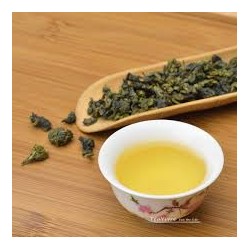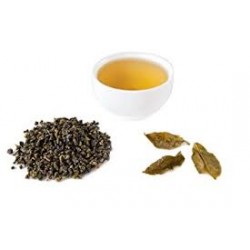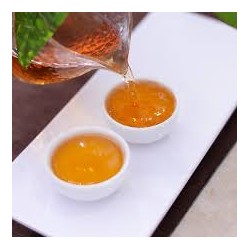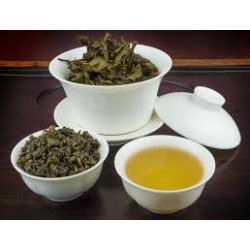No products
Prices are tax included
Oolong tea is obtained from a partial oxidation. It has multiple beneficial health effects.
What's this
Oolong tea can be considered a functional food, thanks to its antioxidant, anti-obesity and hypocholesterolemic properties.
Overview of oolong tea production
Like the other two main qualities of tea (such as green and black tea), oolong is also ob...
Oolong tea is obtained from a partial oxidation. It has multiple beneficial health effects.
What's this
Oolong tea can be considered a functional food, thanks to its antioxidant, anti-obesity and hypocholesterolemic properties.
Overview of oolong tea production
Like the other two main qualities of tea (such as green and black tea), oolong is also obtained from the infusion of the leaves of Camellia sinensis; the difference is that these leaves are prepared slightly differently.
The leaves for the production of oolong tea are left to dry in the sun and then ground; compared to black tea, the exposure times to heat are lower and just enough to oxidize the leaf margins.
After being lightly dried, the leaves are subjected to rotary movements, to facilitate the escape of the cellular juices.
This is how the fermentation processes begin, which gradually move inward from the leaf margins. At the end of this phase, the leaves take on a "mosaic" appearance, due to the presence of fermented reddish and other more verdant regions.
The enzymatic activity and the fermentation processes are immediately arrested, subjecting the leaves to jets of very hot air.
Subsequently they are submitted to a modest rotating pressure (as if they were crushed by a rolling pin) 2-3 times, then dried again.
At the end of the production process, a semi-fermented tea with intermediate characteristics between green (prepared with fresh leaves) and black (dried and left to ferment for longer) is obtained.
Indications
When to use oolong tea?
Consumption of oolong tea is mainly food, although many argue that it can exert therapeutic effects or more generally health benefits.
We recommend the use of oolong tea for:
Fighting free radicals, decreasing cellular aging
Acquire tone, vigor and psycho-physical energy
Complementary slimming diets
Integrating food therapies to treat fat metabolisms, sugars and hypertension (reduction of cardio-vascular risk)
Preventing the deterioration of teeth and bones (osteoporosis)
Obstruct the skin eczema
Reinforce the immune system.
Properties and Effectiveness
What benefits has oolong tea shown during the studies?
Oolong tea benefits from the health properties of both green tea and black tea. These are mainly:
Antioxidants: mainly conferred by polyphenols quercetin and catechin, active on free radicals and protective towards oxidizable molecules. This function is potentially useful in terms of anti-aging and anti-tumor (it is hypothesized that oolong tea contributes to reducing the risk of ovarian cancer in women). Moreover, it protects various molecules circulating in the blood and fundamental for human health, such as lipoproteins for the transport of fats (in particular LDL)
Stimulants: thanks to the moderate content in caffeine, theophylline, theobromine and catechins, which together seem to have a synergistic action in increasing the body metabolism and the speed of fat oxidation, exerting a positive effect on the reduction of body weight. This conclusion has been reached by experimentally noting the major thermogenic effects of oolong tea compared to a water-based drink and similar concentrations in caffeine.
Hypolipidemic: taking this drink regularly can somehow help reduce intestinal absorption of cholesterol. In one study, the consumption of oolong tea by a group of people increased the faecal elimination of lipids.
Anti-atherogenic effect: the antioxidant effects of oolong tea are useful for preventing LDL oxidation.
Hypoglycemic effect: in literature there is also scientific evidence on a possible role in the glycemic reduction of the drink
Note: there is no scientific evidence on a possible preventive role of oolong tea on dental diseases, osteoporosis and eczema.
Doses and Mode of Use
How to use oolong tea?
To take advantage of all the benefits of oolong tea, it is a good rule to prefer the sachets from infusion to ready or instant drinks; prolonged soaking (at least 5 minutes) increases the amount of caffeine and polyphenols in the beverage.
In studies carried out to investigate the health properties, oolong tea was taken in important quantities, on average from 700 ml to 1 liter and a half a day (3-7 sachets of 2 grams / day) for several weeks.
Obviously, we can not expect that some cup of oolong tea remedies the excesses and the irregularities (not just food) that accompany the lives of many people; nevertheless, its mild stimulating action, helping to promote weight loss.
From http://www.my-personaltrainer.it/integratori/te-oolong.html
Tè OOLONG There are 4 products.
-
OOLONG TIEGUAN YIN FRESH AND CREAMY AROMA
Tea Tieguan Yin is the most famous in China, appreciated all over the world.
€0.50In Stock -
JIM XUAN MILKY OOLONG FROM CREAMY SENSORS
Tea oolong Jin Xuan milky is a delicacy appreciated by tea lovers all over the world.
€0.50In Stock -
TE' OOLONG WUYISHAN CREAMY BODY
The most famous Wuyishan oolong tea of the Rock Tea varieties
€0.50In Stock -
TE'OOLONG DONG DING REFRESH WITH SWEETNESS
Dong Ding tea is one of Taiwan's best known and most popular oolong teas.
€0.50In Stock





